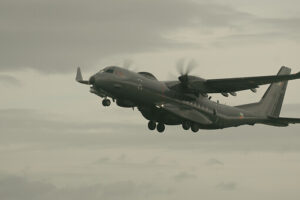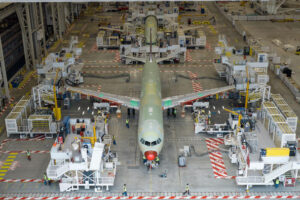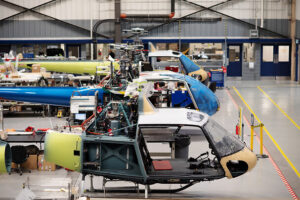
What makes a modern jetliner “powerful”? For most people, it’s a mix of thrust, range, efficiency, and versatility. The Airbus A330neo — short for “New Engine Option” — exemplifies these qualities in a proven airframe that has been reborn for the 21st century. In an era dominated by twinjets, the A330neo has carved out a unique space by blending technological upgrades with economic sensibility.
Launch Customer(s)
Kuwait Airways
Length
192 ft 8 in (58.8 m)
Wingspan
210 ft 0 in (64.0 m)
Height
57 ft 1 in (17.4 m)
Length
208 ft 8 in (63.7 m)
Wingspan
210 ft 0 in (64.0 m)
Height
55 ft 1 in (16.8 m)
As airlines seek fuel-efficient long-haul aircraft that don’t sacrifice payload or passenger comfort, the A330neo stands tall. This guide explores how powerful the aircraft really is — from its thrust-to-weight ratio and engine innovations to its long-haul performance and operational flexibility. Whether you’re an aviation enthusiast or just curious about next-generation aircraft, here’s how the A330neo proves its might.
Reinventing A Classic: What Is The Airbus A330neo?
Photo: Alex Cheban | Wikimedia Commons
Launched in 2014, the Airbus A330neo builds upon the highly successful A330ceo (Current Engine Option) platform. The aircraft comes in two variants: the A330-800 and the more popular A330-900. Both are powered by Rolls-Royce’s purpose-built Trent 7000 engines and feature aerodynamic upgrades like sharklets and a new wing design.
Compared to its predecessor, the Airbus A330neo brings a host of improvements that significantly enhance both efficiency and passenger appeal. One of the most notable advancements is its fuel efficiency — the A330neo delivers up to 25% lower fuel burn per seat, making it a cost-effective option for airlines seeking to reduce operational expenses and emissions.
The cabin has also been upgraded with design elements inspired by the Airbus A350, offering a more modern, comfortable, and quieter passenger experience. In terms of performance, the A330neo boasts a greater range, with the A330-800 capable of flying up to 7,200 nautical miles (13,334 kilometers), opening new long-haul opportunities.
Additionally, enhancements to the aircraft’s aerodynamics and engines contribute to improved takeoff capabilities and greater payload flexibility, making it a versatile asset in any airline fleet. The aircraft’s competitive economics and commonality with other Airbus models have made it a popular choice for airlines looking to modernize without jumping to larger aircraft like the A350 or Boeing 787.
How Powerful Are The Engines On The A330neo?
Photo: Rolls Royce
At the heart of the A330neo is the Rolls-Royce Trent 7000 — a twin-shaft turbofan engine that delivers up to 72,834 pounds of thrust (324 kN). These engines are larger and more efficient than the older Trent 700s used on the A330ceo, with a bypass ratio of 10:1 and a fan diameter of 112 inches (2.84 meters).
This represents a substantial upgrade, directly contributing to the A330neo’s impressive takeoff performance and long-haul range. The Rolls-Royce Trent 7000 engine, central to this advancement, delivers an 11% improvement in specific fuel consumption compared to its predecessor.
Related
How Rolls-Royce Increases The Time-On-Wing For Its Trent 7000 Engines
Rolls-Royce’s Trent 7000 has surpassed one million flying hours since it entered commercial service in 2019.
In addition, it operates with significantly reduced noise and emissions, aligning with modern sustainability standards. Crucially, the Trent 7000 also supports ETOPS 180 (with ETOPS 207 achievable under certain operator certifications), allowing the aircraft to fly extended twin-engine operations over remote oceanic areas.
Engine Specification
Rolls-Royce Trent 7000
Maximum Thrust
72,834 lbs (324 kN)
Bypass Ratio
10:1
Fan Diameter
112 inches (2.84 m)
Fuel Efficiency
+11% vs Trent 700
ETOPS Certification
180/207
What Makes The A330neo So Efficient And Powerful?
Photo: Airbus
The Airbus A330neo’s power doesn’t stem solely from engine thrust — it’s a carefully engineered balance of performance and fuel efficiency. One of the aircraft’s most visible enhancements is its new sharklet wingtips, which are modeled after those found on the Airbus A350. These wingtips reduce drag and improve overall aerodynamic performance.
Additionally, the A330neo features a high-aspect-ratio wing design. This means the wings are longer and narrower, helping to generate more lift with less drag — a key contributor to the aircraft’s fuel efficiency. Airbus also employed advanced lightweight materials throughout the airframe and cabin structure, shaving off unnecessary weight without compromising safety or passenger comfort.
The result of these innovations is a widebody aircraft capable of flying longer distances on less fuel. Even when fully loaded, the A330neo performs with remarkable efficiency. The A330-900, for instance, can carry over 287 passengers across an impressive 6,550 nautical miles (12,130 km), making it a strong fit for long-haul routes such as transatlantic and transpacific services.
Key Performance Metrics
Metric
A330-800
A330-900
Range
7,200 nm (13,334 km)
6,550 nm (12,130 km)
Max Takeoff Weight (MTOW)
251 tonnes
251 tonnes
Max Passengers
406
440
Cruise Speed
Mach 0.82
Mach 0.82
These numbers prove that the A330neo is not just powerful — it’s practical, allowing airlines to deploy it across a wide range of long-haul routes.
How Does It Compare To Other Aircraft?
Photo: Boeing
When compared to competitors like the Boeing 787 Dreamliner, the Airbus A330neo stands out in several strategic areas — particularly operating cost, simplicity, and fleet commonality. For many airlines, these advantages make the A330neo a highly attractive option, especially for carriers already operating Airbus fleets.
One major benefit is the A330neo’s lower acquisition cost, being typically more affordable in terms of list price and leasing than the Boeing 787. This cost-effectiveness extends into operations, where the A330neo shares a common cockpit type rating with other Airbus aircraft, including the A330ceo and A350. This allows airlines to train pilots across multiple Airbus models with minimal additional cost or complexity.
Related
Airbus A330neo Vs Boeing 787-9 – Which Plane Is Best?
Both planes are considered new technology, highly efficient and crowd-pleasers, but which has the edge?
The A330neo is also equipped with high-thrust engines — specifically, the Rolls-Royce Trent 7000 — which deliver strong takeoff and climb performance, even from shorter runways or at hot-and-high airports. However, the aircraft does come with some trade-offs.
Compared to the 787, the A330neo has slightly lower fuel efficiency on ultra-long-haul routes. Its airframe is also heavier, a result of its evolutionary design lineage dating back to the original A330, rather than being a clean-sheet, all-composite design like the Dreamliner. Despite these drawbacks, the A330neo remains a compelling option for many operators seeking a balance between performance, cost, and fleet synergy.
Feature
A330-900
Boeing 787-9
Max Range
6,550 nm
7,565 nm
Typical Seating (2-class)
287
296
Engine Thrust
72,834 lbs (RR Trent)
71,000 lbs (GE/Trent)
Fuel Burn (per seat)
~25% lower than A330ceo
~20% lower than A330ceo
Why Do Airlines Choose The A330neo?
Photo: GVR | Flickr
Many airlines see the A330neo as a natural evolution. It’s especially popular with carriers that already operate the A330ceo, thanks to shared parts, crew training, and maintenance procedures. From a pilot’s perspective, the cockpit layout is almost identical to other Airbus aircraft, making cross-qualification easier and cheaper. Maintenance teams also benefit from reduced transition costs.
The aircraft’s balanced combination of power and range makes it a versatile aircraft well-suited for a wide variety of medium- to long-haul routes. Airlines around the world deploy the A330neo on both flagship transatlantic services and cost-sensitive leisure routes, demonstrating its operational flexibility.
One example is TAP Air Portugal’s prominent Lisbon to São Paulo service, a core transatlantic route that benefits from the A330neo’s fuel efficiency and capacity. In Asia, Cebu Pacific utilizes the A330neo on its Manila to Dubai route, enabling long-haul low-cost travel with a competitive cost base. Meanwhile, Delta Air Lines flies the aircraft from Atlanta to Paris, integrating it into its broader transatlantic network. Malaysia Airlines also leverages the A330neo’s capabilities on routes such as Kuala Lumpur to Melbourne, supporting long-range, high-density leisure travel.
Related
We Flew In Business Class On Malaysia Airlines’ Brand New Airbus A330-900neo: Here’s How It Went
Featuring an enclosed suite, this is the world’s first A330neo to feature the Collins Aerospace Elevation Business Class seats.
This broad deployment range highlights the A330neo’s strength as a flexible asset in airline fleets — equally at home operating point-to-point flights or feeding into major global hubs.
Is The A330neo A Long-Term Solution?
Photo: Alex Cheban | Wikimedia Commons
With continued pressure on airlines to cut emissions, the A330neo’s blend of thrust and efficiency is well-suited for a long future. Airbus is also exploring sustainable aviation fuel (SAF) compatibility and other innovations, keeping the type relevant in a fast-changing industry.
The A330neo supports up to 50% SAF today, with a roadmap towards 100% in the future. This adaptability is critical in a world heading toward net-zero emissions by 2050.
What’s The Final Verdict?
Photo: Airbus
The Airbus A330neo may not grab headlines like the A350 or Boeing 787, but it is undoubtedly powerful — in every sense of the word. Its engines offer significant thrust, its range supports globe-spanning routes, and its efficiency allows airlines to compete profitably.
In a market hungry for sustainable power and versatile performance, the A330neo proves that strength doesn’t have to mean excess. It’s a jetliner engineered for today’s realities — and tomorrow’s ambitions.






